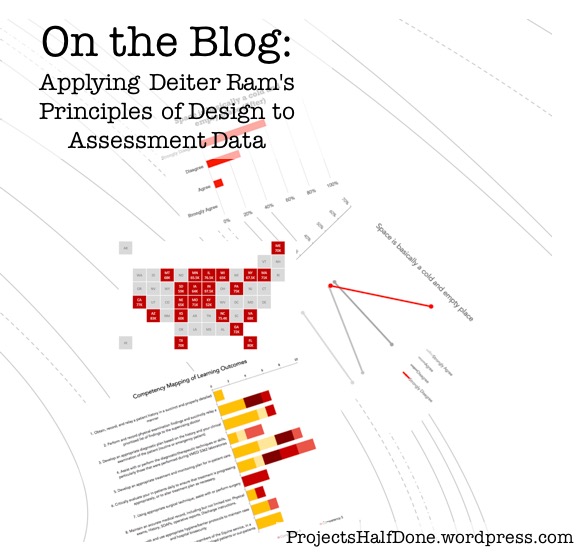
This is the first in a series of Data Visualization Basics blog posts focused on visualizing academic assessment data. Before we begin I should also mention I am not a graphic designer. I’m an assessment person and a social scientist by training and I’ve often been frustrated by the lack of attention our reports get. I find that data visualization can greatly impact our messaging so I hope you find this useful for your work as well.
I want to start this series with some principles of design. These tenants were developed by the German industrial designer Dieter Rams. His products and designs have withstood the test of time because of his sense of design and attention to detail. He developed his method of design in to ten basic principles of that focus on the product.
I have taken these principles and translated them slightly for data visualization because although we are not creating a physical product, the end result is still something that must be well designed and useful if we are going to get the most out of our data.
Good (data visualization) design:
Is innovative
How you’re visualizing data now is very different than the 3-D graphs of the 90’s. We will continue to innovate and develop better design to tell the story of our data.
Makes a product data useful
Data was collected to be used. It was analyzed to be used. This is one of the biggest reasons to engage in data visualization. Our goal is for our assessment data to be useful. Well designed visuals allow us that platform.
Is aesthetic
We want our visuals to be aesthetically pleasing. We want people to do more than glance over them. We want them to engage with them and really understand the meaning. By utilizing an eye-catching visual we can engage the reader much more than with a typical paragraph or data table.
Makes a product data understandable
Sometimes all of those spreadsheets and rows and columns are a headache. Sometimes we miss connections. Good design helps us understand our data. It also helps others understand our key points for programmatic decision making purposes.
Is unobtrusive
Good visuals are unobtrusive. They don’t distract you with unnecessary 3-D images or animations or loud colors. They are a microphone, not a megaphone, for your data.
Is honest
Your visual should be an honest representation of your data. Don’t use a visual to make your data something it isn’t. Don’t dissolve whole categories just to make the visual fit. That’s not good design.
Is long-lasting
10 years from now we should still be able to look at the same report and understand it. Visuals aren’t fashion, they are tools that stand the test of time.
Is thorough down to the last detail
This means every aspect of a graphic is considered. The shape, the balance, the color, the font, the size and the data should all work together to provide the reader with your key points. Font is very often overlooked in so many reports.
Is environmentally economically friendly
Given that many of our reports go online, or in email via PDF our designs are typically environmentally friendly.. It is important to note that our design efforts also be economical. This should be something you can find the time to do with minimal expense.
Involves as little design as possible
Less is more. You don’t need to overdesign, over color, or overthink your visuals. Only the essentials should go in to your visualizations.
When we engage in data visualization considering these principles can help guide our process and ensure that our end result has improved our data reporting process. By considering these factors we can create useful, honest, and clear designed visuals to showcase our data and drive home our critical message.
Do you have any other principles that you consider when doing data visualizations or when working with assessment data? Let me know in the comments!
3 thoughts on “Data Visualization Basics: Applying Deiter Ram’s Principles of Design to Assessment Data”